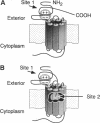Abstract
The guanine nucleotide-binding protein-coupled receptor superfamily binds a vast array of biological messengers including lipids, odorants, catecholamines, peptides, and proteins. While some small molecules bind to these receptors at a single interhelical site, we find that the binding domain on the receptor for the inflammatory protein C5a is more complex and consists of two distinct subsites. This more elaborate motif appears to be an evolutionary adaptation of the simpler paradigm to which a second interaction site has been added in the receptor N terminus. Surprisingly, occupation of only one of the subsites is required for receptor activation. The two-site motif is not unique to the C5a receptor but appears to be widely used by the superfamily to accommodate macromolecular ligands.
Full text
PDF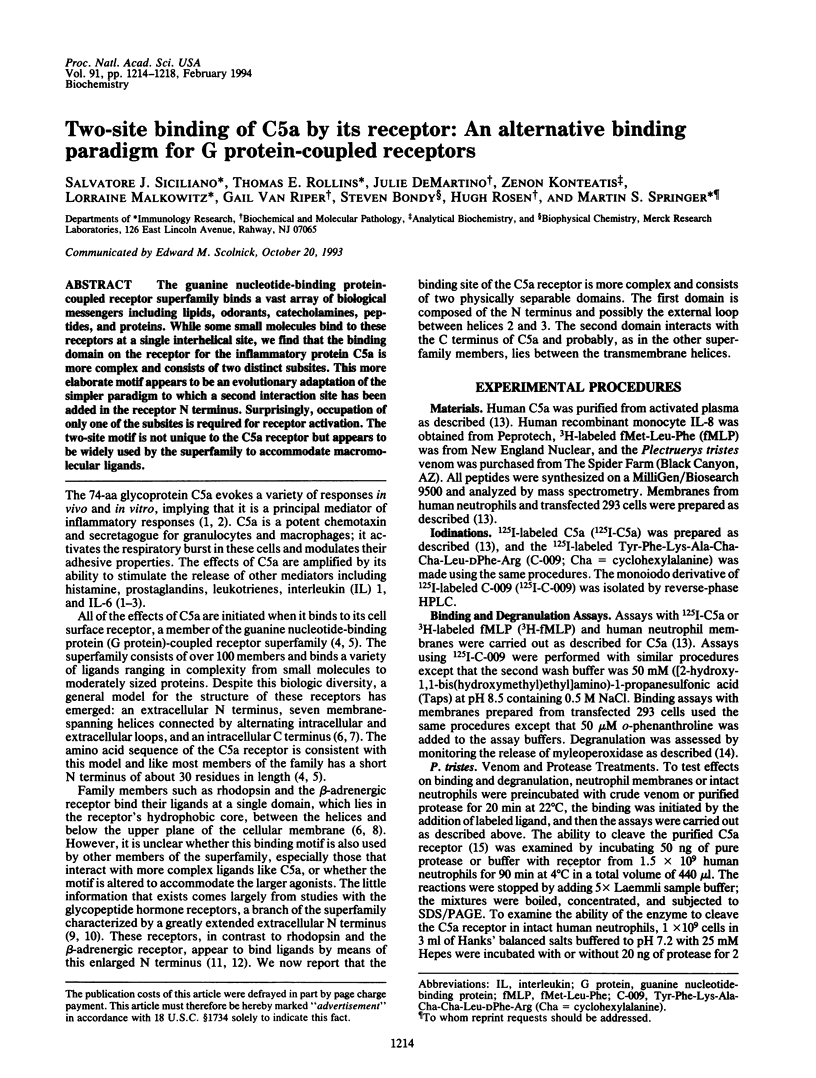
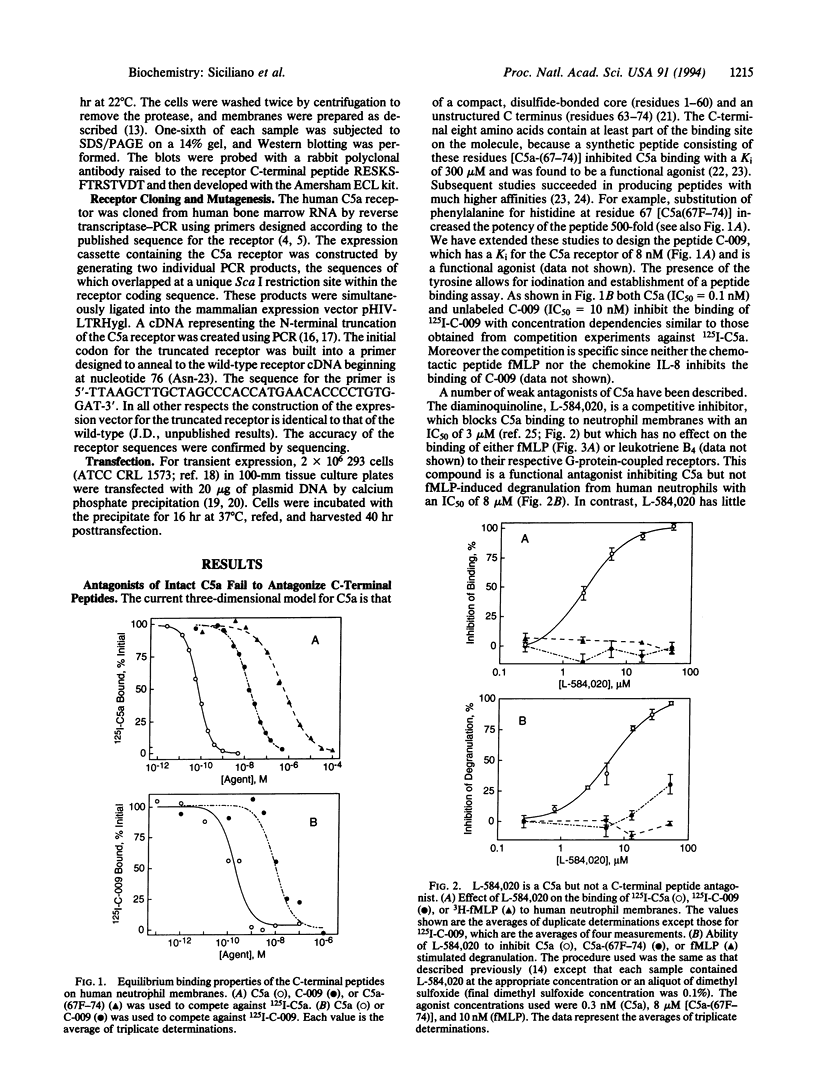
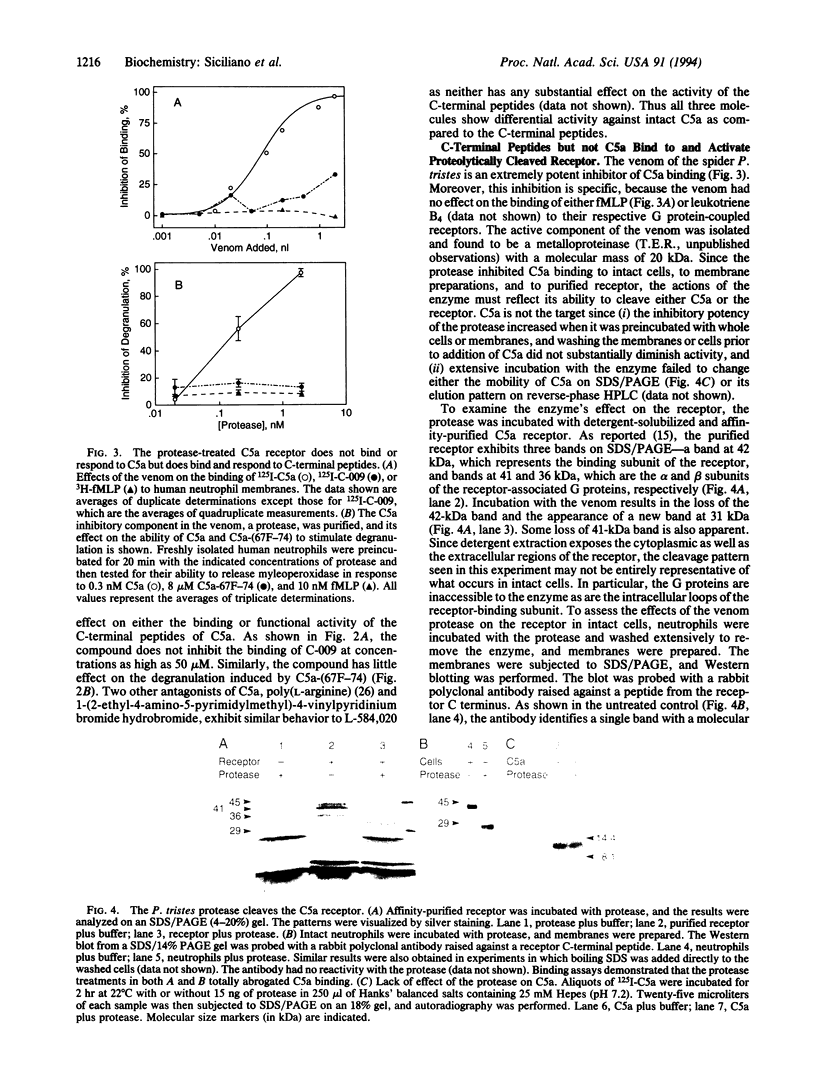
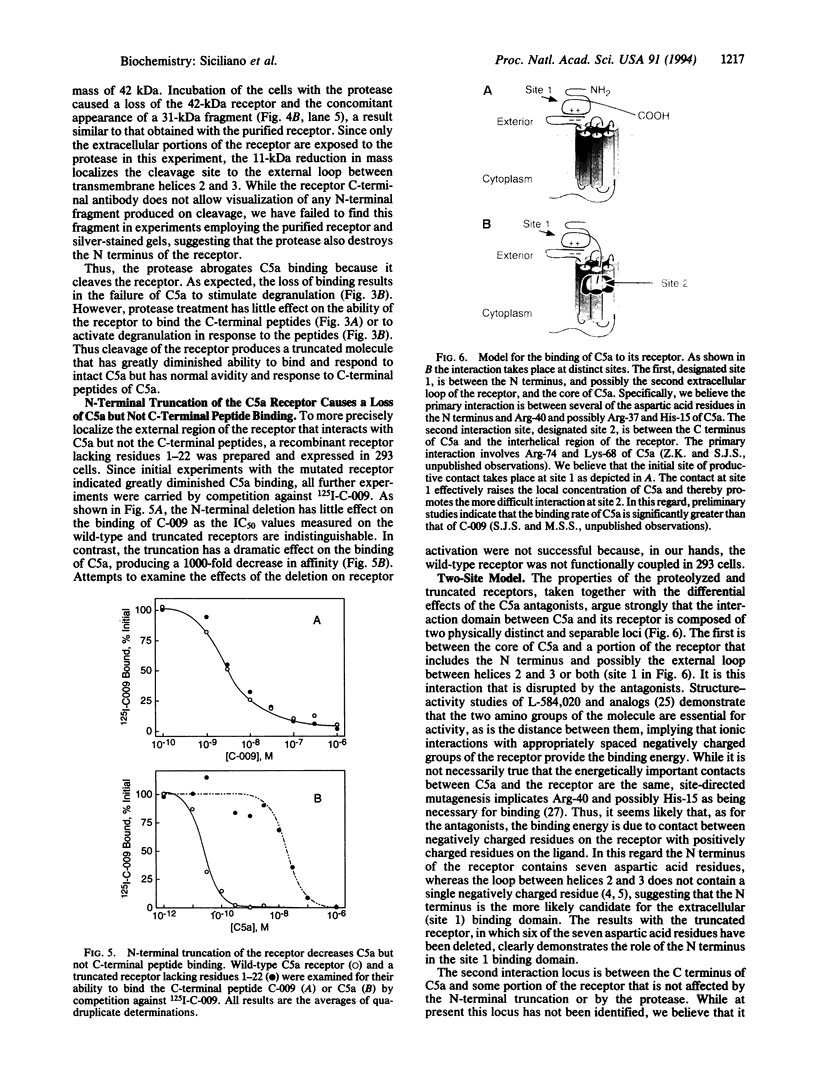
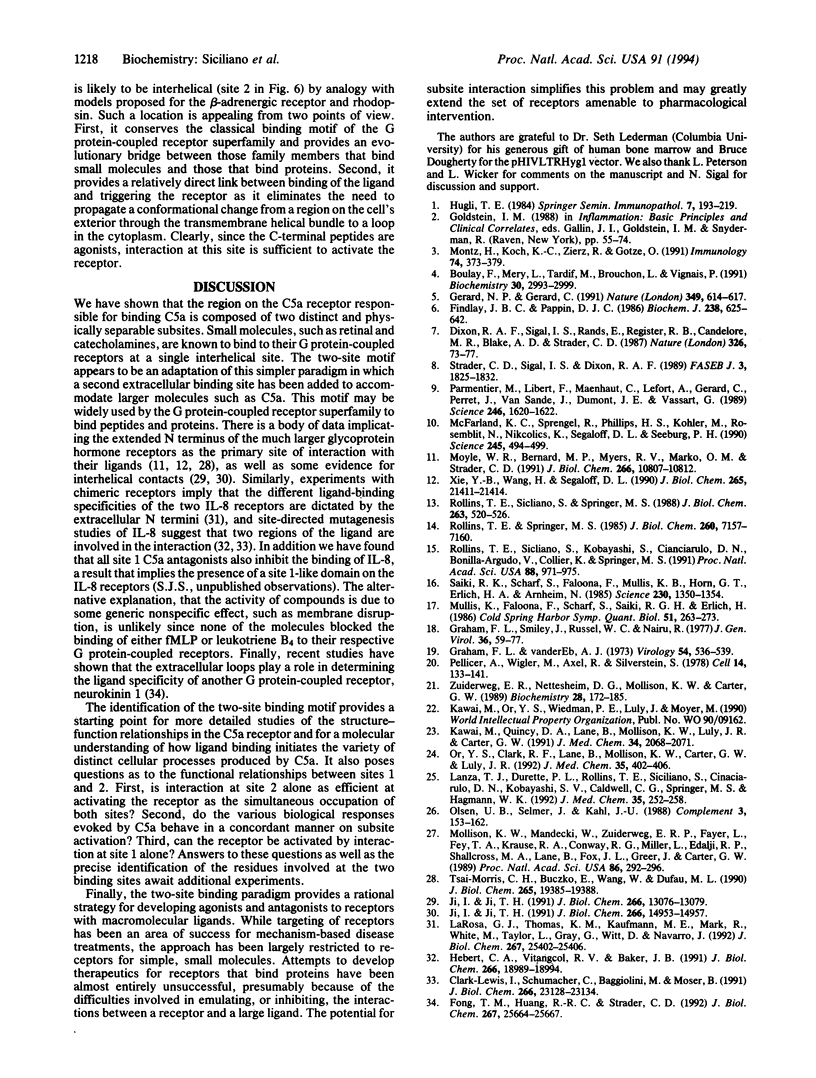
Images in this article
Selected References
These references are in PubMed. This may not be the complete list of references from this article.
- Boulay F., Mery L., Tardif M., Brouchon L., Vignais P. Expression cloning of a receptor for C5a anaphylatoxin on differentiated HL-60 cells. Biochemistry. 1991 Mar 26;30(12):2993–2999. doi: 10.1021/bi00226a002. [DOI] [PubMed] [Google Scholar]
- Clark-Lewis I., Schumacher C., Baggiolini M., Moser B. Structure-activity relationships of interleukin-8 determined using chemically synthesized analogs. Critical role of NH2-terminal residues and evidence for uncoupling of neutrophil chemotaxis, exocytosis, and receptor binding activities. J Biol Chem. 1991 Dec 5;266(34):23128–23134. [PubMed] [Google Scholar]
- Dixon R. A., Sigal I. S., Rands E., Register R. B., Candelore M. R., Blake A. D., Strader C. D. Ligand binding to the beta-adrenergic receptor involves its rhodopsin-like core. Nature. 1987 Mar 5;326(6108):73–77. doi: 10.1038/326073a0. [DOI] [PubMed] [Google Scholar]
- Findlay J. B., Pappin D. J. The opsin family of proteins. Biochem J. 1986 Sep 15;238(3):625–642. doi: 10.1042/bj2380625. [DOI] [PMC free article] [PubMed] [Google Scholar]
- Fong T. M., Huang R. R., Strader C. D. Localization of agonist and antagonist binding domains of the human neurokinin-1 receptor. J Biol Chem. 1992 Dec 25;267(36):25664–25667. [PubMed] [Google Scholar]
- Gerard N. P., Gerard C. The chemotactic receptor for human C5a anaphylatoxin. Nature. 1991 Feb 14;349(6310):614–617. doi: 10.1038/349614a0. [DOI] [PubMed] [Google Scholar]
- Graham F. L., Smiley J., Russell W. C., Nairn R. Characteristics of a human cell line transformed by DNA from human adenovirus type 5. J Gen Virol. 1977 Jul;36(1):59–74. doi: 10.1099/0022-1317-36-1-59. [DOI] [PubMed] [Google Scholar]
- Graham F. L., van der Eb A. J. Transformation of rat cells by DNA of human adenovirus 5. Virology. 1973 Aug;54(2):536–539. doi: 10.1016/0042-6822(73)90163-3. [DOI] [PubMed] [Google Scholar]
- Hugli T. E. Structure and function of the anaphylatoxins. Springer Semin Immunopathol. 1984;7(2-3):193–219. doi: 10.1007/BF01893020. [DOI] [PubMed] [Google Scholar]
- Hébert C. A., Vitangcol R. V., Baker J. B. Scanning mutagenesis of interleukin-8 identifies a cluster of residues required for receptor binding. J Biol Chem. 1991 Oct 5;266(28):18989–18994. [PubMed] [Google Scholar]
- Ji I. H., Ji T. H. Human choriogonadotropin binds to a lutropin receptor with essentially no N-terminal extension and stimulates cAMP synthesis. J Biol Chem. 1991 Jul 15;266(20):13076–13079. [PubMed] [Google Scholar]
- Ji I., Ji T. H. Asp383 in the second transmembrane domain of the lutropin receptor is important for high affinity hormone binding and cAMP production. J Biol Chem. 1991 Aug 15;266(23):14953–14957. [PubMed] [Google Scholar]
- Kawai M., Quincy D. A., Lane B., Mollison K. W., Luly J. R., Carter G. W. Identification and synthesis of a receptor binding site of human anaphylatoxin C5a. J Med Chem. 1991 Jul;34(7):2068–2071. doi: 10.1021/jm00111a022. [DOI] [PubMed] [Google Scholar]
- LaRosa G. J., Thomas K. M., Kaufmann M. E., Mark R., White M., Taylor L., Gray G., Witt D., Navarro J. Amino terminus of the interleukin-8 receptor is a major determinant of receptor subtype specificity. J Biol Chem. 1992 Dec 15;267(35):25402–25406. [PubMed] [Google Scholar]
- Lanza T. J., Durette P. L., Rollins T., Siciliano S., Cianciarulo D. N., Kobayashi S. V., Caldwell C. G., Springer M. S., Hagmann W. K. Substituted 4,6-diaminoquinolines as inhibitors of C5a receptor binding. J Med Chem. 1992 Jan 24;35(2):252–258. doi: 10.1021/jm00080a008. [DOI] [PubMed] [Google Scholar]
- McFarland K. C., Sprengel R., Phillips H. S., Köhler M., Rosemblit N., Nikolics K., Segaloff D. L., Seeburg P. H. Lutropin-choriogonadotropin receptor: an unusual member of the G protein-coupled receptor family. Science. 1989 Aug 4;245(4917):494–499. doi: 10.1126/science.2502842. [DOI] [PubMed] [Google Scholar]
- Mollison K. W., Mandecki W., Zuiderweg E. R., Fayer L., Fey T. A., Krause R. A., Conway R. G., Miller L., Edalji R. P., Shallcross M. A. Identification of receptor-binding residues in the inflammatory complement protein C5a by site-directed mutagenesis. Proc Natl Acad Sci U S A. 1989 Jan;86(1):292–296. doi: 10.1073/pnas.86.1.292. [DOI] [PMC free article] [PubMed] [Google Scholar]
- Montz H., Koch K. C., Zierz R., Götze O. The role of C5a in interleukin-6 production induced by lipopolysaccharide or interleukin-1. Immunology. 1991 Nov;74(3):373–379. [PMC free article] [PubMed] [Google Scholar]
- Moyle W. R., Bernard M. P., Myers R. V., Marko O. M., Strader C. D. Leutropin/beta-adrenergic receptor chimeras bind choriogonadotropin and adrenergic ligands but are not expressed at the cell surface. J Biol Chem. 1991 Jun 15;266(17):10807–10812. [PubMed] [Google Scholar]
- Mullis K., Faloona F., Scharf S., Saiki R., Horn G., Erlich H. Specific enzymatic amplification of DNA in vitro: the polymerase chain reaction. Cold Spring Harb Symp Quant Biol. 1986;51(Pt 1):263–273. doi: 10.1101/sqb.1986.051.01.032. [DOI] [PubMed] [Google Scholar]
- Olsen U. B., Selmer J., Kahl J. U. Complement C5a receptor antagonism by protamine and poly-L-Arg on human leukocytes. Complement. 1988;5(3):153–162. doi: 10.1159/000463049. [DOI] [PubMed] [Google Scholar]
- Or Y. S., Clark R. F., Lane B., Mollison K. W., Carter G. W., Luly J. R. Improvements in the minimum binding sequence of C5a: examination of His-67. J Med Chem. 1992 Jan 24;35(2):402–406. doi: 10.1021/jm00080a030. [DOI] [PubMed] [Google Scholar]
- Parmentier M., Libert F., Maenhaut C., Lefort A., Gérard C., Perret J., Van Sande J., Dumont J. E., Vassart G. Molecular cloning of the thyrotropin receptor. Science. 1989 Dec 22;246(4937):1620–1622. doi: 10.1126/science.2556796. [DOI] [PubMed] [Google Scholar]
- Pellicer A., Wigler M., Axel R., Silverstein S. The transfer and stable integration of the HSV thymidine kinase gene into mouse cells. Cell. 1978 May;14(1):133–141. doi: 10.1016/0092-8674(78)90308-2. [DOI] [PubMed] [Google Scholar]
- Rollins T. E., Siciliano S., Kobayashi S., Cianciarulo D. N., Bonilla-Argudo V., Collier K., Springer M. S. Purification of the active C5a receptor from human polymorphonuclear leukocytes as a receptor-Gi complex. Proc Natl Acad Sci U S A. 1991 Feb 1;88(3):971–975. doi: 10.1073/pnas.88.3.971. [DOI] [PMC free article] [PubMed] [Google Scholar]
- Rollins T. E., Siciliano S., Springer M. S. Solubilization of the functional C5a receptor from human polymorphonuclear leukocytes. J Biol Chem. 1988 Jan 5;263(1):520–526. [PubMed] [Google Scholar]
- Rollins T. E., Springer M. S. Identification of the polymorphonuclear leukocyte C5a receptor. J Biol Chem. 1985 Jun 25;260(12):7157–7160. [PubMed] [Google Scholar]
- Saiki R. K., Scharf S., Faloona F., Mullis K. B., Horn G. T., Erlich H. A., Arnheim N. Enzymatic amplification of beta-globin genomic sequences and restriction site analysis for diagnosis of sickle cell anemia. Science. 1985 Dec 20;230(4732):1350–1354. doi: 10.1126/science.2999980. [DOI] [PubMed] [Google Scholar]
- Strader C. D., Sigal I. S., Dixon R. A. Structural basis of beta-adrenergic receptor function. FASEB J. 1989 May;3(7):1825–1832. doi: 10.1096/fasebj.3.7.2541037. [DOI] [PubMed] [Google Scholar]
- Tsai-Morris C. H., Buczko E., Wang W., Dufau M. L. Intronic nature of the rat luteinizing hormone receptor gene defines a soluble receptor subspecies with hormone binding activity. J Biol Chem. 1990 Nov 15;265(32):19385–19388. [PubMed] [Google Scholar]
- Xie Y. B., Wang H., Segaloff D. L. Extracellular domain of lutropin/choriogonadotropin receptor expressed in transfected cells binds choriogonadotropin with high affinity. J Biol Chem. 1990 Dec 15;265(35):21411–21414. [PubMed] [Google Scholar]
- Zuiderweg E. R., Nettesheim D. G., Mollison K. W., Carter G. W. Tertiary structure of human complement component C5a in solution from nuclear magnetic resonance data. Biochemistry. 1989 Jan 10;28(1):172–185. doi: 10.1021/bi00427a025. [DOI] [PubMed] [Google Scholar]




